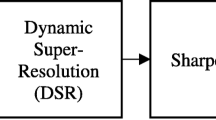Abstract
A common method for reconstructing a turbulence scene is through the creation of an artificial reference image. The reference image is usually obtained by averaging video through time. Using optical flow from that reference image to input images would give rise to such applications as: super-resolution, tracking, and so forth. This technique, however, suffers from several drawbacks: the resulting artificial reference image is blurred, so the calculated optical flow is not precise and limits the ability of higher level applications (such as super-resolution, tracking, mosaics). We present a mathematical framework for reconstructing a video scene as would have been seen without turbulence interference, yielding an observable live video output. We then use both frames and optical flow to get the aforementioned applications while dealing with camera motion, and draw guidelines to deal with in-scene motion inherently.
Preview
Unable to display preview. Download preview PDF.
Similar content being viewed by others
References
Shimizu, M., Yoshimura, S., M.T., Okutomi, M.: Restoration of atmospheric turbulent video containing real motion using rank filtering and elastic image registration. In: CVPR (2008)
Gepshtein, S., Shtainman, A., B.F., Yaroslavsky, L.: Restoration of atmospheric turbulent video containing real motion using rank filtering and elastic image registration. In: EUSIPCO (2004)
Elad, M., Feuer, A.: Restoration of a single superresolution image from several blurred, noisy, and undersampled measured images. Image Processing (1997)
Irani, M., Peleg, S.: Improving resolution by image registration. Graphical Model and Image Processing (1991)
Brox, T., Bruhn, A., Papenberg, N., Weickert, J.: High accuracy optical flow estimation based on a theory for warping. In: Pajdla, T., Matas, J(G.) (eds.) ECCV 2004. LNCS, vol. 3024, pp. 25–36. Springer, Heidelberg (2004)
Author information
Authors and Affiliations
Editor information
Editors and Affiliations
Rights and permissions
Copyright information
© 2009 Springer-Verlag Berlin Heidelberg
About this paper
Cite this paper
Avidor, T., Golan, M. (2009). A Method for Removal of Turbulence Disturbance from Video, Enabling Higher Level Applications. In: Kamel, M., Campilho, A. (eds) Image Analysis and Recognition. ICIAR 2009. Lecture Notes in Computer Science, vol 5627. Springer, Berlin, Heidelberg. https://doi.org/10.1007/978-3-642-02611-9_64
Download citation
DOI: https://doi.org/10.1007/978-3-642-02611-9_64
Publisher Name: Springer, Berlin, Heidelberg
Print ISBN: 978-3-642-02610-2
Online ISBN: 978-3-642-02611-9
eBook Packages: Computer ScienceComputer Science (R0)




